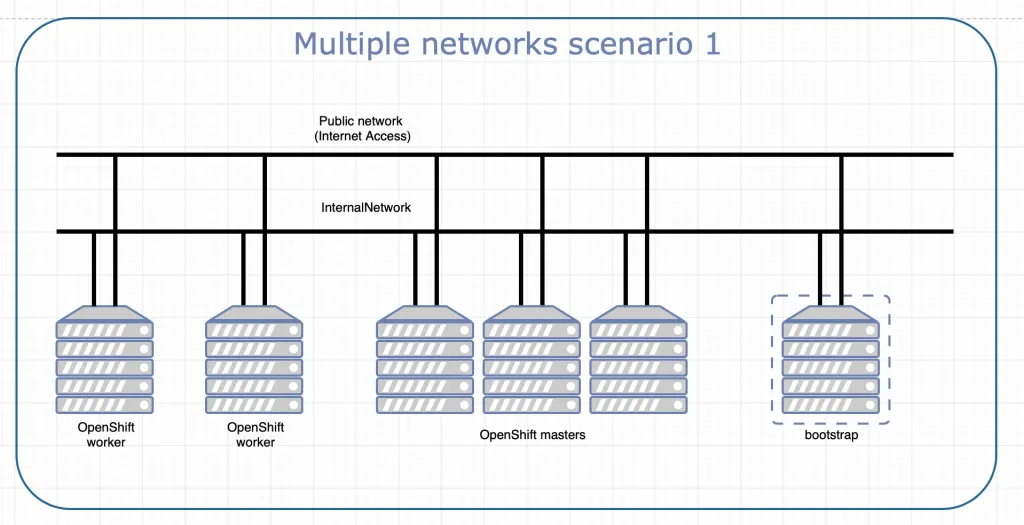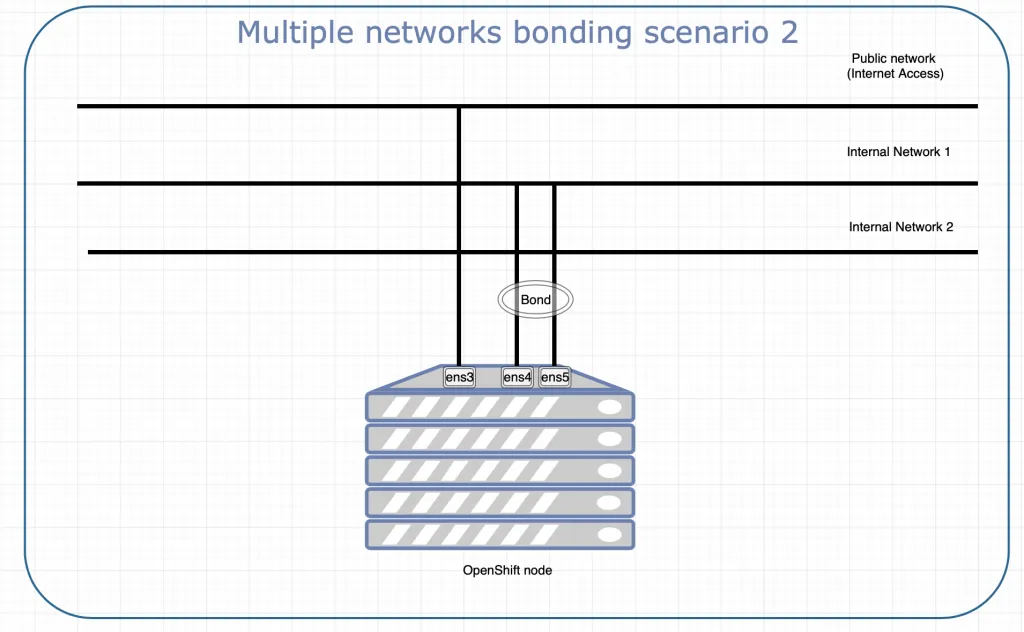Each organization has its own unique IT environment, and sometimes it will not fit within the network configuration which Red Hat OpenShift sets by default. Thus, it becomes essential to customize the installation for the target environment. In this blog we are going to showcase how to do the advanced network related customization and configuration needed to accomplish this.
Planning
The first step in implementing or deploying any product is determining the specifications of the target environment.
How do you define your target environment?
- What will be the MTU size on your physical network?
- OpenShift’s MTU size should always be smaller than the transport network’s MTU by at least 50 bytes if using OVS.
- Similarly if you are using any 3rd party SDN plugin along with OpenShift’s OVN which, consists of GENEVE and VXLAN, make sure to account for bytes due to its encapsulations.
- Is your virtualization platform already using VXLAN? If so, what port is it utilizing?
- How many networks are laid out for each of the OpenShift nodes? Is there any preference to use any specific network for SDN?
- Do you plan to bond together the different networks adaptors for redundancy purposes?
- What type of network mode you are planning to use i.e. network policy or multi tenant?
- Do you plan to use a DHCP server to provide persistent IP and server names, or do you want to inject this information via ignition files?
- Is your OpenShift cluster behind the proxy? Do you want to use enterprise NTP servers on to your masters to avoid any unnecessary latency issues.
In this blog we are going to showcase how to do advanced network related customizations and configurations during the OpenShift deployment for the above stated points. Note that this blog should only be used for customizing the primary interface i.e. OpenShift Container Platform (OCP) SDN. For customizing secondary interfaces i.e. net1,net2 , the SRIOV Machine Configuration Operator (MCO) should be directly used.
Multiple networks scenario:
There are scenarios where customers will not be able to open up external/internet access on the internal network due to security concerns. As long as you can attach both public/external networks and the internal network to the OpenShift nodes, you will be able to do the connected deployment. All you need to do is inject the proper default gateway into your ignition files. This example describes the steps to generate the custom ignition file for such scenarios.

In order to make any customizations to the ignition file, we will use a tool called filetranspiler.
You can download it with the following commands:
curl -o ./utils/filetranspile https://raw.githubusercontent.com/ashcrow/filetranspiler/master/filetranspile
chmod +x ./utils/filetranspile
Download the python-yaml package on your RHEL server. This package is required due to the filetranspiler dependencies.
yum -y install python3-pyyaml
Create a “fakeroot” filesystem for each OpenShift node you want to make an ignition file.
mkdir -p bootstrap/etc/sysconfig/network-scripts/
Create a network configuration inside the “fakeroot” filesystem. For example, in this scenario we will make these files for each of the interfaces.
cat < bootstrap/etc/sysconfig/network-scripts/ifcfg-ens3
DEVICE=ens3
BOOTPROTO=none
ONBOOT=yes
IPADDR=192.168.7.20
NETMASK=255.255.255.0
GATEWAY=192.168.7.1
DNS1=192.168.1.77
DOMAIN=ocp.example.com
PREFIX=24
DEFROUTE=yes
IPV6INIT=no
EOF
cat < bootstrap/etc/sysconfig/network-scripts/ifcfg-ens4
DEVICE=ens4
BOOTPROTO=none
ONBOOT=yes
IPADDR=192.168.1.20
NETMASK=255.255.255.0
GATEWAY=192.168.7.1
DNS1=192.168.1.77
DOMAIN=ocp.example.com
PREFIX=24
DEFROUTE=yes
IPV6INIT=no
EOF
Note: Here Default gateway is of public/external network!!
Using filetranspiler, create a new ignition file based on the one created by openshift-install.
Please note in this example, bootstrap.ign is my original ignition file created by the openshift-install. Continuing with the example of my bootstrap server; it looks like this.
filetranspiler -i bootstrap.ign -f bootstrap -o bootstrap-static.ign
The syntax is: filetranspiler -i $ORIGINAL -f $FAKEROOTDIR -o $OUTPUT
NOTE: If you’re using the container version of filetranspiler, you need to be in the directory where these files/dirs are. In other words, absolute paths won’t work.
In this way, you can create your customized ignition file for each of the node types; i.e. master or worker.
Multiple networks bonding scenario:
There are scenarios where customers will not be able to open up external/internet access on the internal network due to security concerns. As long as you can attach both public/external network and internal network to the OpenShift nodes, you will be able to do the connected deployment. All you need to do is to inject the proper default gateway into your ignition files. This example describes the steps to generate the custom ignition file for such scenarios. In this scenario, we also showcase how to pass the bond information into the ignition files.


Create a “fakeroot” filesystem structure for each OpenShift node you want to make an ignition file.
mkdir -p bootstrap/etc/sysconfig/network-scripts/
Create a network configuration inside the “fakeroot” filesystem. For example in this scenario we will make these files for each of the interfaces.
cat < bootstrap/etc/sysconfig/network-scripts/ifcfg-ens3
DEVICE=ens3
BOOTPROTO=none
ONBOOT=yes
IPADDR=192.168.7.20
NETMASK=255.255.255.0
GATEWAY=192.168.7.1
DNS1=192.168.7.77
DOMAIN=ocp.example.com
PREFIX=24
DEFROUTE=yes
IPV6INIT=no
EOF
cat < bootstrap/etc/sysconfig/network-scripts/ifcfg-bond0
DEVICE=bond0
TYPE=Bond
NAME=bond0
BONDING_MASTER=yes
BOOTPROTO=none
ONBOOT=yes
IPADDR=192.168.1.70
NETMASK=255.255.255.0
GATEWAY=192.168.7.1
BONDING_OPTS="mode=5 miimon=100"
cat < bootstrap/etc/sysconfig/network-scripts/ifcfg-ens4
TYPE=Ethernet
DEVICE=ens4
BOOTPROTO=none
ONBOOT=yes
HWADDR="08:00:27:69:60:c9"
MASTER=bond0
SLAVE=yes
EOF
cat < bootstrap/etc/sysconfig/network-scripts/ifcfg-ens5
TYPE=Ethernet
DEVICE=ens5
BOOTPROTO=none
ONBOOT=yes
HWADDR="08:00:27:69:60:c6"
MASTER=bond0
SLAVE=yes
EOF
cat < bootstrap/etc/resolv.conf
search ocp.example.com
nameserver 192.168.7.1
EOF
Note: Here Default gateway is a public/external network!!
Specify the IP address, Netmask & Bonding modes as per your requirement. In my example I am using ‘mode=5′ which is used to provide fault tolerance and load balancing.
Using filetranspiler, create a new ignition file based on the one created by openshift-install.
Please note in this example bootstrap.ign is my original ignition file created by the openshift-install utility. Continuing with the example of my bootstrap server; it looks like this:
filetranspiler -i bootstrap.ign -f bootstrap -o bootstrap-static.ign
In this way, you can create your customized ignition file for each of the node types; i.e. master or worker.
Setting up MTU size or VXLAN port number scenario:
If the target environment requires a particular MTU size packet then you can follow the steps below.
Use the following command to create manifests:
$ ./openshift-install create manifests --dir=<installation_directory>
Create a file that is named cluster-network-03-config.yml in the <installation_directory>/manifests/ directory:
$ touch <installation_directory>/manifests/cluster-network-03-config.yml
cat < <installation_directory>/manifests/cluster-network-03-config.yml
apiVersion: operator.openshift.io/v1
kind: Network
metadata:
name: cluster
spec:
clusterNetwork:
- cidr: 10.128.0.0/14
hostPrefix: 23
serviceNetwork:
- 172.30.0.0/16
defaultNetwork:
type: OpenShiftSDN
openshiftSDNConfig:
mode: NetworkPolicy
mtu: 1450
vxlanPort: 4789
Note: The above MTU of 1450 is allocated because of the additional encapsulation overhead, i.e. always consider 50 bytes less than what is set on the physical transport side.
defaultNetwork: This section configures the network isolation mode for OpenShiftSDN. The allowed values are Multitenant, Subnet, or NetworkPolicy. The default value is NetworkPolicy.
Mtu: MTU for the VXLAN overlay network. This value is normally configured automatically, but if the nodes in your cluster do not all use the same MTU, then you must set this explicitly to 50 less than the smallest node MTU value.
vxlanPort: The port to use for all VXLAN packets. The default value is 4789. If you are running in a virtualized environment with existing nodes that are part of another VXLAN network, then you might be required to change this. For example, when running an OpenShift SDN overlay on top of VMware NSX-T, you must select an alternate port for VXLAN, since both SDNs use the same default VXLAN port number.
Alternatively, you can also specify the cluster network configuration for your OpenShift Container Platform cluster by setting the parameters for the defaultNetwork parameter in the CNO CR.
apiVersion: operator.openshift.io/v1
kind: Network
metadata:
name: cluster
spec:
clusterNetwork:
- cidr: 10.128.0.0/14
hostPrefix: 23
serviceNetwork:
- 172.30.0.0/16
defaultNetwork:
...
kubeProxyConfig:
iptablesSyncPeriod: 30s
proxyArguments:
iptables-min-sync-period:
- 30s
kubeProxyConfig: The parameters for this object specify the kube-proxy configuration. If you do not specify the parameter values, the Network Operator applies the displayed default parameter values.
iptablesSyncPeriod: The refresh period for iptables rules. The default value is 30s. Valid suffixes include s, m, and h and are described in the Go time package documentation.
Iptables-min-sync-period: The minimum duration before refreshing iptables rules. This parameter ensures that the refresh does not happen too frequently. Valid suffixes include s, m, and h and are described in the Go time package.
Injecting static IP and server name scenario:
For static IPs, you need to generate new ignition files based on the ones that the OpenShift installer generated. You can use the filetranspiler tool to make this process a little easier. This is an example from the bootstrap node.
When using filetranspiler you first need to create a “fakeroot” filesystem.
mkdir -p bootstrap/etc/sysconfig/network-scripts/
Create your network configuration inside this fakeroot.
cat < bootstrap/etc/sysconfig/network-scripts/ifcfg-ens3
DEVICE=ens3
BOOTPROTO=none
ONBOOT=yes
IPADDR=192.168.7.20
NETMASK=255.255.255.0
GATEWAY=192.168.7.1
DNS1=192.168.7.77
DNS2=8.8.8.8
DOMAIN=ocp4.example.com
PREFIX=24
DEFROUTE=yes
IPV6INIT=no
EOF
cat < bootstrap/etc/hostname
Bootstrap-hostname
EOF
NOTE: Your interface WILL probably differ, be sure to determine the persistent name of the device(s) before creating the network configuration files.
Using filetranspiler, create a new ignition file based on the one created by openshift-install. Continuing with the example of my bootstrap server; it looks like this.
filetranspiler -i bootstrap.ign -f bootstrap -o bootstrap-static.ign
Injecting enterprise NTP server information scenario:
If the OpenShift cluster is sitting behind the corporate proxy, then it will be a good idea to use an enterprise NTP server rather than what is available on the internet to avoid any latency and firewall issues. One of the ways is to inject the NTP information directly into the ignition files if you are unable to inject it via your DHCP server.
When using filetranspiler you first need to create a “fakeroot” filesystem.
vi master/etc/chrony.conf
Create your chrony configuration inside this fakeroot.
cat < master/etc/chrony.conf
# Use public servers from the pool.ntp.org project.
# Please consider joining the pool (http://www.pool.ntp.org/join.html).
pool 2.enterprise.pool.ntp.org iburst
# Record the rate at which the system clock gains/losses time.
driftfile /var/lib/chrony/drift
# Allow the system clock to be stepped in the first three updates
# if its offset is larger than 1 second.
makestep 1.0 3
# Enable kernel synchronization of the real-time clock (RTC).
rtcsync
# Enable hardware timestamping on all interfaces that support it.
#hwtimestamp *
# Increase the minimum number of selectable sources required to adjust
# the system clock.
#minsources 2
# Allow NTP client access from local network.
#allow 192.168.0.0/16
# Serve time even if not synchronized to a time source.
#local stratum 10
# Specify file containing keys for NTP authentication.
keyfile /etc/chrony.keys
# Get TAI-UTC offset and leap seconds from the system tz database.
leapsectz right/UTC
# Specify directory for log files.
logdir /var/log/chrony
# Select which information is logged.
#log measurements statistics tracking
EOF
Using filetranspiler, create a new ignition file based on the one created by openshift-install. Continuing with the example of my master server; it looks like this.
filetranspiler -i master.ign -f master -o master-static.ign
Using filetranspiler, create a new ignition file based on the one created by openshift-install. Continuing with the example of my master server; it looks like this.
filetranspiler -i master.ign -f master -o master-static.ign
Conclusion:
As you can see from the post, with the help of filetranspiler tool, you can customize your ignition files at the deployment stage. This will help you deploy the OpenShift cluster in the target environment of your choice. There are other tools available to do such customizations in the ignition level i.e. jqplay. And lastly, for further customizations of your OpenShift cluster refer to this github link.
執筆者紹介
チャンネル別に見る
自動化
テクノロジー、チームおよび環境に関する IT 自動化の最新情報
AI (人工知能)
お客様が AI ワークロードをどこでも自由に実行することを可能にするプラットフォームについてのアップデート
オープン・ハイブリッドクラウド
ハイブリッドクラウドで柔軟に未来を築く方法をご確認ください。
セキュリティ
環境やテクノロジー全体に及ぶリスクを軽減する方法に関する最新情報
エッジコンピューティング
エッジでの運用を単純化するプラットフォームのアップデート
インフラストラクチャ
世界有数のエンタープライズ向け Linux プラットフォームの最新情報
アプリケーション
アプリケーションの最も困難な課題に対する Red Hat ソリューションの詳細
オリジナル番組
エンタープライズ向けテクノロジーのメーカーやリーダーによるストーリー
製品
ツール
試用、購入、販売
コミュニケーション
Red Hat について
エンタープライズ・オープンソース・ソリューションのプロバイダーとして世界をリードする Red Hat は、Linux、クラウド、コンテナ、Kubernetes などのテクノロジーを提供しています。Red Hat は強化されたソリューションを提供し、コアデータセンターからネットワークエッジまで、企業が複数のプラットフォームおよび環境間で容易に運用できるようにしています。
言語を選択してください
Red Hat legal and privacy links
- Red Hat について
- 採用情報
- イベント
- 各国のオフィス
- Red Hat へのお問い合わせ
- Red Hat ブログ
- ダイバーシティ、エクイティ、およびインクルージョン
- Cool Stuff Store
- Red Hat Summit

